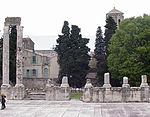Canton of Arles
Cantons of Bouches-du-Rhône

The canton of Arles is an administrative division of the Bouches-du-Rhône department, in southeastern France. It was created at the French canton reorganisation which came into effect in March 2015. Its seat is in Arles.
Excerpt from the Wikipedia article Canton of Arles (License: CC BY-SA 3.0, Authors, Images).Canton of Arles
Rue Chiavary, Arles
Geographical coordinates (GPS) Address Nearby Places Show on map
Geographical coordinates (GPS)
| Latitude | Longitude |
|---|---|
| N 43.68 ° | E 4.63 ° |
Address
Parking Zone Rouge
Rue Chiavary
13200 Arles
Provence-Alpes-Côte d'Azur, France
Open on Google Maps






